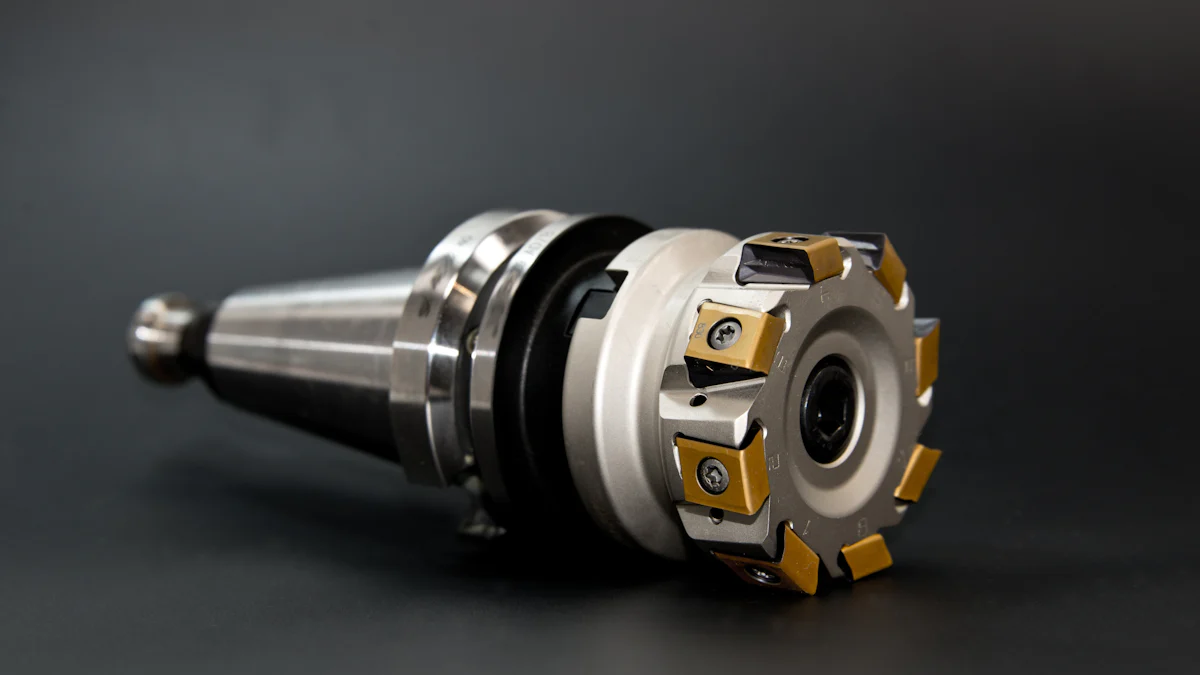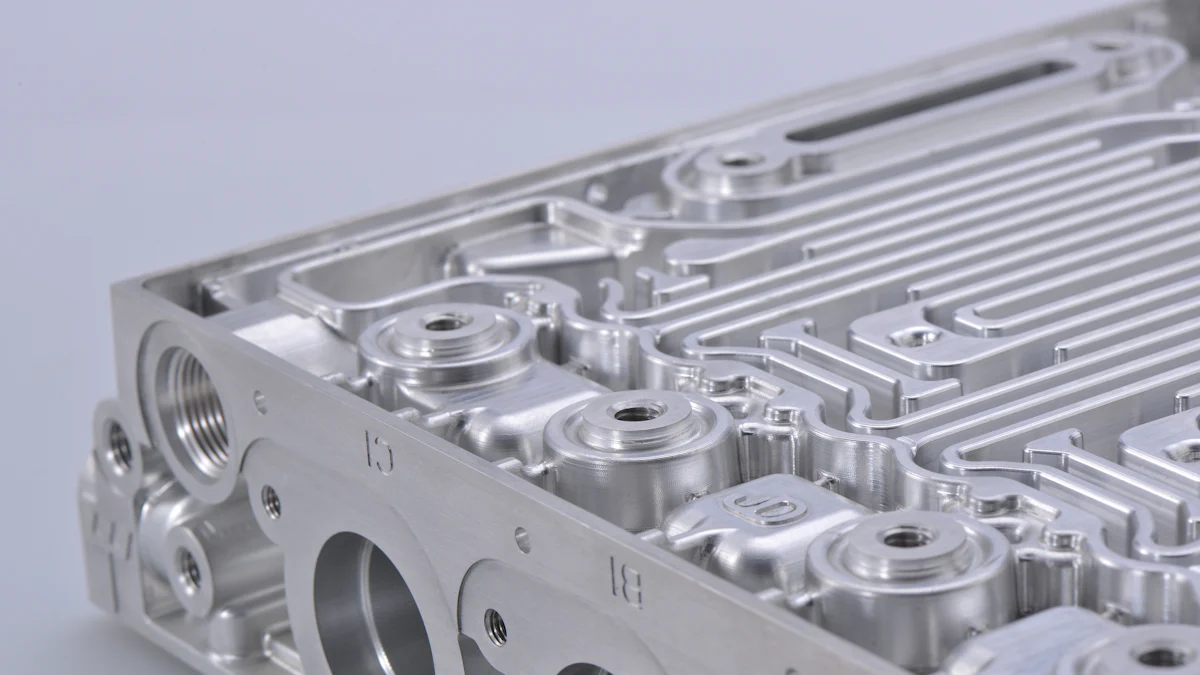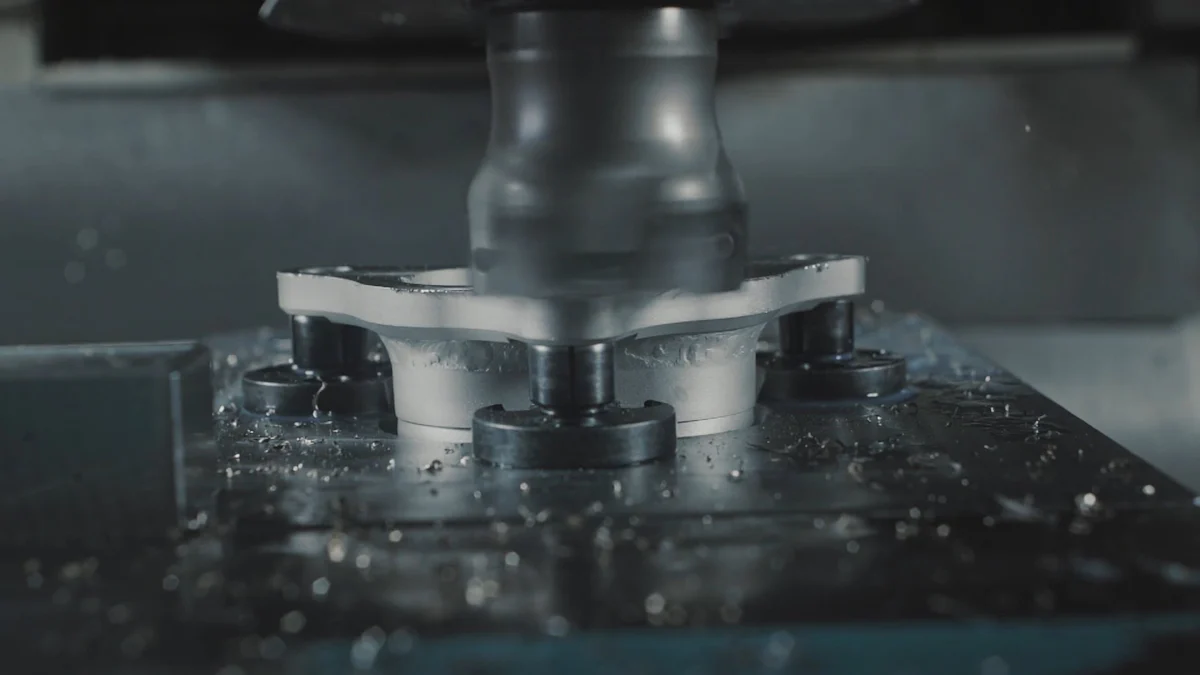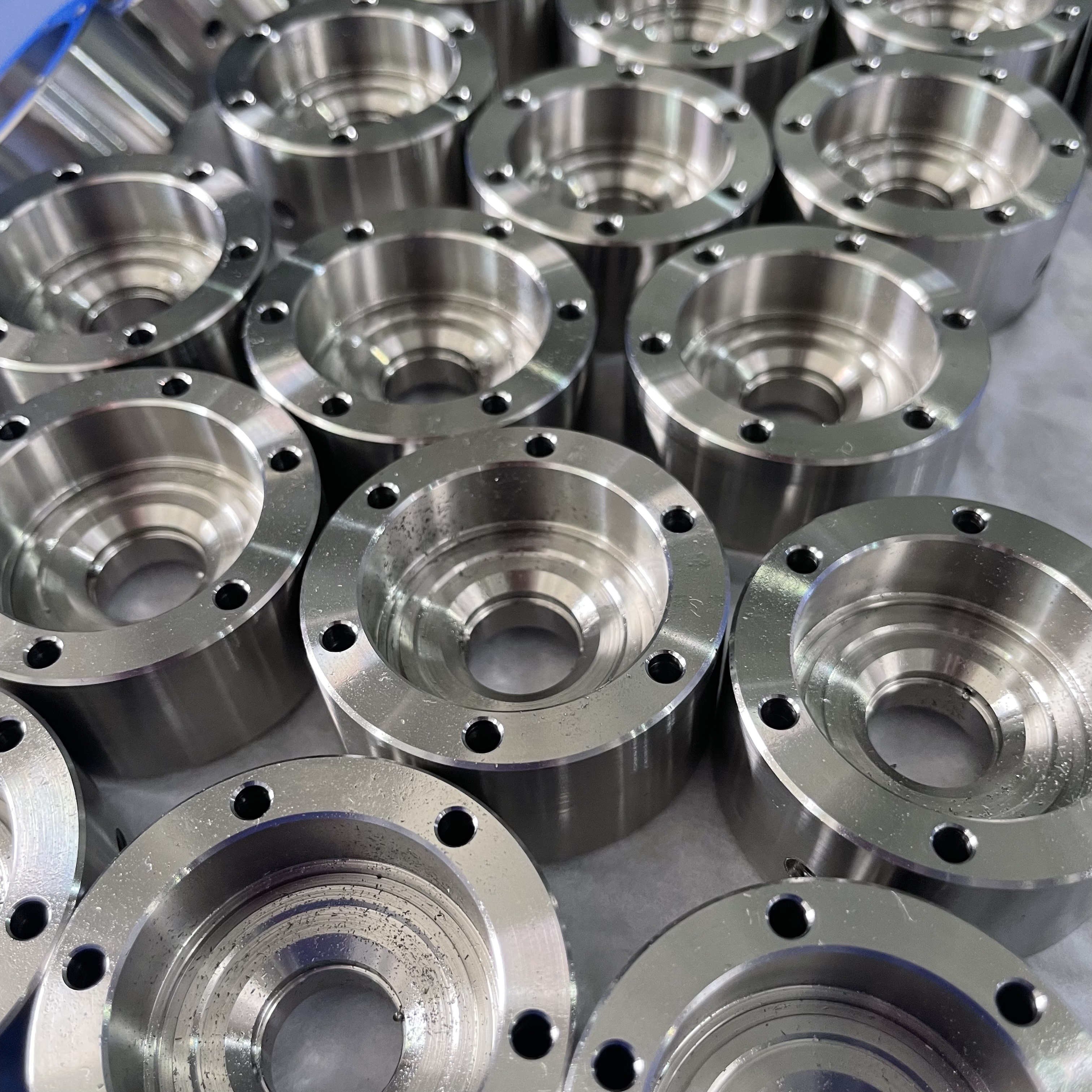Best Materials for Vibration Damping in CNC Machined Parts

Vibration damping plays a critical role in CNC machining. It reduces tool chatter, enhances precision, and extends the durability of machined parts. Materials like cast iron, aluminum, composites, polymers, and alloys excel in this area. For instance, viscoelastic polymers such as Sorbothane absorb high-frequency vibrations, while heavy-duty rubber works well for low-frequency impacts. Silicone rubber withstands extreme temperatures, making it ideal for demanding applications. Using vibration isolation mounts or rubber bumpers can further improve performance by isolating shock and vibration. These damping techniques ensure better vibration control, leading to improved machining performance and part quality.
Key Takeaways
Cast iron is great for stopping vibrations. It is strong and absorbs vibrations well, making it perfect for precise CNC work.
Aluminum is light and reduces some vibrations. It works well when weight needs to be low, like in planes or cars.
Composites can be made to control vibrations. They are useful in lightweight jobs like building airplane parts or robots.
Polymers, like Sorbothane, are very good at soaking up vibrations. They help tools work better and reduce noise in CNC projects.
When picking materials, think about vibration levels, where it will be used, and cost. This helps make CNC projects last longer and work better.
Cast Iron for Vibration Damping

Properties of Cast Iron
Cast iron stands out for its exceptional ability to dampen vibration. Compared to mild steel, it offers significantly higher damping characteristics, making it ideal for applications where vibrations occur at resonant frequencies. Gray cast iron, in particular, excels due to its high rigidity and superior damping capacity. It absorbs vibrations effectively, which is essential for maintaining machining accuracy. Ductile iron also performs well, with a damping capacity roughly twice that of steel. However, gray cast iron surpasses ductile iron, offering nearly double the vibration damping capability. These properties make cast iron a preferred choice for reducing unwanted vibrations in CNC machining.
Advantages in CNC Machining
You’ll find cast iron highly beneficial in CNC machining due to its unique combination of properties. Its high rigidity ensures stability during operations, while its excellent damping capacity minimizes tool chatter and enhances precision. Cast iron also provides good thermal stability, maintaining dimensional accuracy even when temperatures fluctuate. Additionally, its high wear resistance contributes to the longevity of CNC equipment. These advantages make cast iron particularly suitable for high-precision machining tasks.
Key benefits of cast iron in CNC machining include:
High rigidity for stable machining.
Superior vibration damping capacity.
Good thermal stability for consistent performance.
High wear resistance for extended durability.
Limitations of Cast Iron
Despite its advantages, cast iron has some limitations you should consider. Its hardness makes it more challenging to machine, especially malleable cast iron. While it can deliver a fine surface finish and precise dimensions, the machining process may require additional effort. Cast iron’s heavy weight also increases the overall weight of the machine, which can affect mobility and setup. Furthermore, its lower toughness makes it prone to breaking under impact. These factors may limit its use in certain CNC machining applications.
Key limitations of cast iron include:
Difficult machinability due to hardness.
Heavy weight, reducing machine mobility.
Lower toughness, increasing susceptibility to breakage.
Applications in Reducing Tool Chatter
Cast iron plays a vital role in reducing tool chatter during CNC machining. Tool chatter occurs when vibrations disrupt the cutting process, leading to poor surface finishes and reduced precision. You can rely on cast iron’s exceptional damping properties to minimize these vibrations and maintain machining accuracy.
One common application involves machine tool bases and frames. These components often use cast iron because of its ability to absorb vibrations generated during high-speed machining. By stabilizing the machine, cast iron ensures smoother operations and better-quality parts. You’ll notice this especially in industries like automotive and aerospace, where precision is critical.
Another area where cast iron excels is in the production of lathe beds and milling machine tables. These parts experience constant vibration from cutting tools. Cast iron’s rigidity and damping capacity reduce these vibrations, allowing you to achieve tighter tolerances and finer finishes. This makes it an excellent choice for machining intricate or delicate components.
You can also find cast iron in vibration-damping inserts and fixtures. These accessories help secure workpieces during machining, preventing movement caused by vibrations. By using cast iron inserts, you can improve the stability of your setup and reduce the risk of tool chatter.
Aluminum and Its Damping Properties
Characteristics of Aluminum
Aluminum is a versatile material known for its lightweight nature and moderate vibration damping capabilities. While it does not match the vibration absorption of cast iron, it still performs well in many CNC machining applications. Cast aluminum, in particular, offers a balance between strength and damping, making it suitable for components where weight reduction is critical.
Here’s a comparison of vibration damping between aluminum and cast iron:
Vibration Damping | |
|---|---|
Cast Aluminum | Moderate |
Cast Iron | Excellent |
This table highlights aluminum’s moderate ability to reduce vibration, which can still be effective in applications requiring precision and stability.
Benefits for CNC Machined Parts
Aluminum offers several advantages when used in CNC machined parts. Its unique properties make it a popular choice for industries like aerospace and automotive.
Aluminum’s low density provides an excellent strength-to-weight ratio, ideal for weight-sensitive applications.
Its softer structure allows for faster cutting speeds, reducing tool wear and improving machining efficiency.
Aluminum is easier to machine than many metals, leading to faster production times and lower costs.
The lightweight nature of aluminum reduces the load on CNC machinery, enhancing overall performance.
These benefits make aluminum a practical option for projects requiring precision, efficiency, and weight reduction.
Drawbacks of Aluminum
Despite its advantages, aluminum has some limitations. Its vibration damping properties are moderate, which may not suffice for applications requiring high vibration absorption. This can lead to increased tool chatter in certain scenarios. Additionally, aluminum’s lower rigidity compared to materials like cast iron can affect stability during machining.
You may also find that aluminum’s softer structure, while beneficial for machinability, makes it more prone to surface damage. This can require additional finishing processes to achieve the desired durability and appearance. These drawbacks should be considered when selecting aluminum for CNC machining projects.
Common Applications in CNC Machining
You’ll find aluminum widely used in CNC machining due to its versatility and unique properties. Its lightweight nature and moderate vibration damping make it suitable for a variety of applications across industries.
Aerospace Components
Aluminum is a go-to material for aerospace parts. Its excellent strength-to-weight ratio helps reduce the overall weight of aircraft. You’ll see it used in structural components, brackets, and housings. These parts benefit from aluminum’s machinability, which allows for precise and intricate designs.Automotive Parts
In the automotive industry, aluminum plays a key role in manufacturing lightweight yet durable components. Engine blocks, transmission housings, and suspension parts often rely on aluminum. Its ability to reduce vibrations enhances the performance and longevity of these parts.Electronics Enclosures
Aluminum’s thermal conductivity and moderate damping properties make it ideal for electronic enclosures. It helps dissipate heat while protecting sensitive components from vibrations. You’ll notice its use in laptops, smartphones, and other consumer electronics.Medical Equipment
Aluminum is also common in medical devices. Its lightweight and corrosion-resistant nature make it suitable for surgical instruments and diagnostic equipment. CNC machining ensures these parts meet strict precision and quality standards.Robotics and Automation
Aluminum components are essential in robotics. Its low weight reduces the load on robotic arms, improving efficiency. You’ll find it in frames, joints, and other structural parts where precision and stability are critical.
Aluminum’s adaptability makes it a practical choice for CNC machining. Whether you’re working on aerospace, automotive, or electronics projects, it offers a balance of performance and efficiency.
Composites for Enhanced Vibration Damping

Key Properties of Composites
Composites stand out as effective materials for vibration damping due to their unique properties. These materials combine fibers and a matrix to create a structure that offers exceptional performance. You’ll find the following properties make composites ideal for reducing vibration and enhancing machining precision:
High strength-to-weight ratio: Composites like carbon fiber-reinforced polymers (CFRP) are lightweight yet strong, making them suitable for weight-sensitive applications.
Corrosion resistance: Composites resist moisture and chemicals, ensuring durability in harsh environments.
Fatigue resistance: These materials handle repeated stress cycles without significant wear, maintaining their structural integrity.
Tailored properties: By adjusting the composition and fiber orientation, you can customize composites to meet specific vibration absorption needs.
These characteristics allow composites to deliver reliable performance in CNC machining applications.
Advantages in CNC Machining
Using composites in CNC machining offers several benefits. Their ability to absorb vibration improves machining accuracy and reduces tool chatter. This leads to smoother finishes and higher-quality parts. The lightweight nature of composites also reduces the load on CNC machines, enhancing efficiency and extending equipment life. Additionally, their corrosion resistance ensures long-term durability, even in challenging conditions.
Composites also allow for design flexibility. You can engineer them to meet specific requirements, such as enhanced vibration absorption or increased strength. This makes them a versatile choice for industries like aerospace, automotive, and robotics, where precision and performance are critical.
Challenges and Limitations
Despite their advantages, composites present some challenges in CNC machining. The abrasive fibers can cause rapid tool wear, increasing costs and affecting part quality. Delamination, where layers separate during milling, can compromise the structural integrity of parts. Heat generated during machining may degrade the polymer matrix, impacting surface finish and strength. Improper milling techniques can also lead to fiber pullout and burr formation, resulting in rough surfaces.
Additionally, the varying material properties within composites can cause uneven vibration and noise during machining. This may affect the precision of the final product. Addressing these challenges requires careful planning, specialized tools, and optimized machining techniques.
Use Cases in CNC Machined Parts
Composites have become a game-changer in CNC machining, offering unique advantages for specific applications. You’ll find them used in industries where precision, lightweight structures, and vibration control are critical. Here are some common use cases:
Aerospace Components
Composites like carbon fiber-reinforced polymers (CFRP) are widely used in aerospace. Their lightweight nature reduces the overall weight of aircraft, improving fuel efficiency. You’ll see them in parts like wing spars, fuselage panels, and rotor blades. These components benefit from the vibration damping properties of composites, ensuring smoother operation and longer service life.Automotive Parts
In the automotive industry, composites help reduce vehicle weight while maintaining strength. This improves fuel economy and performance. You’ll notice their use in body panels, suspension components, and interior parts. Their ability to absorb vibrations enhances ride comfort and reduces noise.Robotics and Automation
Composites play a key role in robotics. Their high strength-to-weight ratio makes them ideal for robotic arms and structural frames. You’ll find that their vibration damping properties improve precision during high-speed operations, ensuring accurate movements and reduced wear on components.Medical Equipment
Medical devices often require materials that combine precision and durability. Composites meet these needs in applications like imaging equipment, surgical tools, and prosthetics. Their vibration damping capabilities enhance the accuracy of diagnostic machines, while their lightweight nature improves usability.
Tip: When designing CNC machined parts, consider composites for applications requiring both strength and vibration control. Their tailored properties can help you achieve optimal performance.
Sports and Recreation Equipment
Composites are common in high-performance sports gear. You’ll see them in bicycles, tennis rackets, and golf clubs. Their vibration damping properties improve user comfort and performance, making them a preferred choice for athletes.
By leveraging composites in these applications, you can achieve superior results in CNC machining projects. Their versatility and performance make them a valuable material for modern manufacturing.
Polymers and Their Damping Capabilities
Material Properties of Polymers
Polymers are highly effective materials for vibration damping due to their unique properties. Their viscoelastic nature allows them to absorb and dissipate energy, making them ideal for reducing unwanted vibrations in CNC machined parts. Different types of polymers offer distinct advantages based on their composition and structure.
Polymer Type | Key Properties | Applications |
|---|---|---|
Polyurethane | Versatile, durable, resilient, viscoelastic, energy absorption, temperature stability | Packaging, Automotive, Construction, Sports Equipment |
Polyvinyl Chloride (PVC) | Durable, flexible, sound barrier, quick vibration absorption | Enclosure surfaces |
Viscoelastic Polymers | Elastic and viscous behaviors, stores vibration energy, releases heat | General vibration damping applications |
Viscoelastic materials, such as Sorbothane, combine elasticity and viscosity to store vibration energy and release it as heat. This dual behavior makes them particularly effective for CNC machining applications where precision and stability are critical.
Benefits for Vibration Damping
Polymers provide several advantages for vibration damping in CNC machining. Their viscoelasticity ensures efficient energy absorption and dissipation, reducing tool chatter and improving machining accuracy. These materials also maintain performance across a wide temperature range, making them reliable in various operating conditions.
Polymer concrete, which replaces traditional cement binders with polymer binders, significantly enhances vibration damping. It is commonly used in CNC machine frames to reduce ringing sounds and improve stability.
Polymers are lightweight, making them ideal for applications where reducing the overall weight of components is essential.
Their durability ensures long-term performance, even in demanding environments.
You’ll often find polymers used in industrial machinery, where vibration isolation is crucial for maintaining precision and extending equipment life.
Limitations in CNC Applications
Despite their advantages, polymers have limitations in CNC machining. Their lower tensile strength compared to metals like stainless steel or titanium restricts their use in high-load or structural applications. Plastics such as ABS and Nylon may deform under heavy stress, limiting their suitability for certain tasks.
Temperature resistance is another challenge. Polymers have specific thresholds, such as the Heat Deflection Temperature (HDT) and Glass Transition Temperature (Tg), which determine their ability to withstand heat without deforming. For example:
HDT: The temperature at which a polymer deforms under load.
Tg: The point where an amorphous polymer becomes brittle or viscous.
Continuous Use Temperature (CUT): The maximum temperature a polymer can endure without degrading.
These factors require careful consideration when selecting polymers for CNC machining, especially in high-stress or high-temperature environments.
Examples of Polymer Applications
Polymers play a vital role in CNC machining, especially when vibration damping is a priority. Their unique properties make them suitable for a wide range of applications. Here are some examples where polymers excel:
Machine Tool Bases
Polymer concrete is a popular choice for CNC machine tool bases. It absorbs vibrations effectively, ensuring stable operations. You’ll notice this material used in high-precision machines where even minor vibrations can affect accuracy. Its lightweight nature also reduces the overall weight of the equipment.Vibration Isolation Pads
Many CNC setups use viscoelastic polymers like Sorbothane for vibration isolation pads. These pads sit between the machine and its foundation, absorbing vibrations and preventing them from transferring to the surrounding environment. This improves machining precision and reduces noise.Workpiece Fixtures
Polymers such as polyurethane are often used in fixtures that hold workpieces during machining. These fixtures dampen vibrations, keeping the workpiece stable. This ensures better surface finishes and reduces the risk of tool chatter.Protective Covers and Enclosures
Polymers like PVC are ideal for protective covers and enclosures. They shield sensitive components from vibrations while also providing durability and flexibility. You’ll find these covers in CNC machines that operate in harsh environments.Industrial Equipment Components
Polymers are used in gears, bushings, and bearings within CNC machines. Their vibration damping properties reduce wear and tear, extending the lifespan of these components. This makes them a cost-effective choice for long-term use.
Tip: When selecting polymers for CNC applications, consider their vibration damping capacity and temperature resistance. This ensures optimal performance and durability.
Polymers offer versatility and efficiency in CNC machining. By incorporating them into your projects, you can achieve better precision, reduced noise, and longer equipment life.
Alloys for CNC Machining and Vibration Damping
Properties of Alloys
Alloys combine two or more metals to create materials with enhanced properties. These materials often exhibit superior strength, durability, and resistance to wear. For CNC machining, alloys like stainless steel, titanium, and nickel-based alloys stand out. Their ability to withstand high stress and maintain stability under vibration makes them ideal for precision applications. Some alloys also offer excellent thermal conductivity, which helps dissipate heat during machining. This reduces the risk of thermal deformation and ensures consistent performance.
You can also find alloys tailored for specific needs. For example, aluminum alloys balance lightweight properties with moderate vibration damping. On the other hand, copper-based alloys excel in absorbing vibrations while providing excellent machinability. These diverse characteristics make alloys a versatile choice for CNC machined parts.
Advantages in Reducing Tool Chatter
Alloys play a crucial role in minimizing tool chatter during CNC machining. Their inherent strength and rigidity help stabilize the cutting process, reducing unwanted vibrations. This stability ensures smoother operations and improves the surface finish of machined parts. Alloys with high damping capacity, such as copper-nickel alloys, absorb vibrations effectively. This prevents oscillations that can disrupt machining accuracy.
In industries like aerospace and automotive, alloys are essential for components that demand both strength and vibration control. You’ll see them used in engine mounts, exhaust systems, and structural parts. These applications benefit from the alloy’s ability to reduce noise and enhance precision.
Limitations of Alloys
Despite their advantages, alloys present some challenges in CNC machining. High-strength alloys can lead to increased tool wear, raising operational costs. Machining time may also increase for complex designs, affecting overall efficiency. Some alloys, like titanium, are more difficult and expensive to machine. This impacts machining speed and quality, requiring specialized tools and techniques.
Key limitations of alloys include:
High tool wear, increasing costs.
Longer machining times for intricate designs.
Difficulty in machining certain alloys, affecting efficiency.
These factors require careful consideration when selecting alloys for CNC machining projects.
Applications in CNC Machined Parts
Alloys play a vital role in CNC machining, especially when vibration damping is essential. Their unique properties make them suitable for a wide range of applications across industries. Here are some common uses where alloys excel:
Engine Components
Alloys like titanium and nickel-based materials are widely used in engine parts. Their strength and vibration damping capabilities ensure smooth operation and durability. You’ll find them in turbine blades, engine mounts, and exhaust systems. These components benefit from the alloy’s ability to handle high temperatures and reduce noise.Machine Tool Frames
CNC machines often rely on alloy-based frames for stability. Copper-nickel alloys, for instance, absorb vibrations effectively, ensuring precise machining. This stability improves the quality of the finished product and extends the life of the machine.Aerospace Structures
In aerospace, alloys like aluminum and titanium are indispensable. Their lightweight nature reduces the overall weight of aircraft, while their vibration damping properties enhance performance. You’ll see them in fuselage panels, landing gear, and wing components.Medical Devices
Alloys such as stainless steel and cobalt-chromium are common in medical equipment. Their biocompatibility and vibration control make them ideal for surgical instruments, implants, and diagnostic machines. These materials ensure precision and reliability in critical applications.Automotive Parts
Automotive manufacturers use alloys in suspension systems, engine blocks, and transmission housings. Their ability to reduce vibrations improves ride comfort and extends the lifespan of components.
Tip: When selecting alloys for CNC machining, consider the specific requirements of your project. Focus on factors like strength, vibration damping, and thermal resistance to achieve the best results.
Alloys provide unmatched versatility and performance in CNC machining. By leveraging their properties, you can enhance precision, reduce tool chatter, and improve the durability of your parts.
Factors Influencing Material Selection for Vibration Damping
Operating Environment Considerations
The operating environment plays a critical role in selecting materials for vibration damping. You need to evaluate the types of vibrations present in your workspace. For example, external vibrations from nearby machinery can interfere with CNC machining processes. Materials with natural vibration-damping properties, such as cast iron or composites, can help mitigate these disturbances.
Machine tool manufacturers often prioritize materials that enhance structural rigidity. This approach minimizes vibrations and improves machining precision. You should also consider the specific industrial application. For instance, factories with heavy-duty operations may require materials like polymer concrete for their superior damping capabilities. Understanding your operational environment ensures you choose materials that align with your needs.
Temperature Resistance and Stability
Temperature resistance is another key factor when selecting materials for vibration damping. High temperatures during CNC machining can cause materials to expand or lose stability. Materials like Invar, known for its minimal thermal expansion, are ideal for temperature-sensitive applications. Stainless steels, such as 304 and 316, offer excellent stability and corrosion resistance in harsh conditions.
For lightweight applications, aluminum alloys like 6061 and 7075 strike a balance between strength and machinability. Polymers such as UHMW-PE and POM (Delrin) provide high dimensional stability and wear resistance. Choosing materials with low thermal expansion and high stability ensures consistent performance and reduces tool chatter caused by thermal deformation.
Cost and Budget Constraints
Budget constraints often influence material selection. You should compare the cost-effectiveness of different options while balancing performance and availability. For instance, polymers like polyurethane are cost-efficient and versatile, making them suitable for many applications.
Conducting a detailed cost analysis helps you evaluate initial material costs, machining expenses, and long-term maintenance. This ensures you select materials that meet performance requirements without exceeding your budget. Balancing financial efficiency with vibration-damping needs is essential for successful CNC machining projects.
Machinability and Customization Options
When selecting materials for CNC machining, machinability plays a crucial role. It determines how easily you can cut, shape, or finish a material. Materials with high machinability reduce tool wear, save time, and lower production costs. For example, aluminum and brass are highly machinable, making them ideal for projects requiring quick turnaround times. On the other hand, harder materials like titanium or stainless steel may require specialized tools and techniques, increasing complexity.
Customization options also impact your material choice. Some materials allow you to tailor properties like strength, weight, or vibration damping. Composites, for instance, let you adjust fiber orientation to enhance specific characteristics. Similarly, alloys can be engineered to balance machinability with performance. These options give you the flexibility to meet unique project requirements.
Tip: Always match the material’s machinability with your CNC machine’s capabilities. This ensures efficient operations and prevents unnecessary tool wear.
Here’s a quick comparison of machinability across common materials:
Material | Machinability | Customization Potential |
|---|---|---|
Aluminum | Excellent | Moderate |
Cast Iron | Moderate | Low |
Composites | Challenging | High |
Polymers | Excellent | High |
Alloys | Varies (e.g., Brass: High, Titanium: Low) | High |
You should also consider the tools and techniques required for machining. For example, polymers and aluminum allow faster cutting speeds, while composites may need diamond-coated tools to prevent fiber damage. Understanding these factors helps you optimize your machining process.
Note: Materials with low machinability often require more time and resources. Plan your budget accordingly to avoid unexpected costs.
By evaluating machinability and customization options, you can select materials that align with your project goals. This approach ensures precision, efficiency, and cost-effectiveness in your CNC machining tasks.
Selecting the right material for vibration damping in CNC machining depends on your specific needs. Cast iron offers excellent damping and stability for high-precision tasks. Aluminum provides a lightweight option with moderate vibration control. Composites excel in weight-sensitive applications, while polymers like polyurethane and Sorbothane absorb vibrations effectively across frequencies. Alloys balance strength and damping, making them versatile for demanding environments.
To choose the best material, evaluate the type and frequency of vibrations, environmental conditions, and your budget. For high-frequency vibrations, viscoelastic polymers work well. Heavy-duty rubbers or metal composites handle low-frequency vibrations better. Always consider durability, machinability, and compatibility with other materials to ensure optimal performance.
FAQ
What is the best material for vibration damping in CNC machining?
The best material depends on your application. Cast iron offers excellent damping for high-precision tasks. Composites work well in weight-sensitive projects. Polymers like Sorbothane absorb high-frequency vibrations. Alloys balance strength and damping, making them versatile for demanding environments.
How do vibration-damping materials improve CNC machining?
These materials reduce tool chatter and stabilize the machining process. This improves surface finish, enhances precision, and extends tool life. You’ll also notice reduced noise and better overall performance in your CNC operations.
Are polymers suitable for high-temperature CNC applications?
Polymers like UHMW-PE and POM (Delrin) handle moderate temperatures well. For high-temperature environments, you should consider materials with higher heat resistance, such as silicone-based polymers or specialized alloys.
Can lightweight materials like aluminum provide effective vibration damping?
Aluminum offers moderate vibration damping. It works best in applications where weight reduction is critical. For better damping, you can use aluminum alloys or combine aluminum with vibration-damping inserts.
How do I choose the right material for my CNC project?
Evaluate your project’s needs. Consider vibration frequency, operating environment, and budget. For high-frequency vibrations, use viscoelastic polymers. For structural stability, choose cast iron or alloys. Always balance machinability, durability, and cost for optimal results.
Tip: Test materials in your specific setup to ensure they meet your performance requirements.
See Also
Grasping Material Needs for CNC Precision Machining Success
Excelling in CNC Machining for High-Quality Parts Production
Proven Strategies for Flawless CNC Machining of Aluminum
Achieving Excellence in CNC Milling for Precision Components
Streamlined CNC Machining Solutions for Precision Fabrication
About US
Follow Us
Your prototype holds unparalleled significance, and we deeply value its uniqueness. Collaborating with you during the preparation phase for running your prototype or parts is a commitment we gladly embrace. Whether it's a single part or a complex assembly, we are dedicated to selecting the optimal tools and pathways to bring your envisioned product to life.
At Precision Fab CNC Machining, we specialize in producing parts for prototypes, short runs, and high-volume production. Our prototyping machine capabilities extend across metal, plastic, and wood machining, with welding fabrication services available to complement and finalize your prototype if required.
Address
Address: Room320 10F, Building A,Nanshan international building, Dayawan District, Huizhou, Guangdong, 516001 China
Contacts
billy@timaycnc.com

